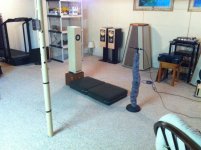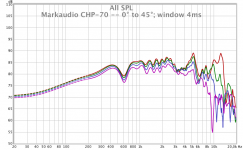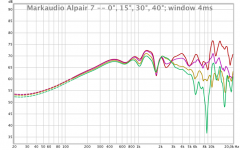I've completed my altered pensil P70.3 speakers using the Markaudio CHP-70 drivers.
I've documented my work every step of the way. I wanted to focus more on how to construct the cabinets in a general DIY sense for the beginner. I think this part of our hobby is lacking. Some of the things we think are obvious may not be to a beginner. I've included some extra elements to the cabinet that I think help, one being a deflector plate at the rear of the cabinet.
The links can be found here:
Introduction
Joseph Crowe's DIY Speaker Building Blog: Markaudio CHP-70 Enclosure Build Part One
Part 2
Part 3
Joseph Crowe's DIY Speaker Building Blog: Markaudio CHP-70 Enclosure Build Part Four
Final Measurements


http://3.bp.blogspot.com/-MmWXl7zN2Ws/U-y_HBsj-aI/AAAAAAAABwI/VE7aOAXr4OI/s1600/image11.jpeg
I've documented my work every step of the way. I wanted to focus more on how to construct the cabinets in a general DIY sense for the beginner. I think this part of our hobby is lacking. Some of the things we think are obvious may not be to a beginner. I've included some extra elements to the cabinet that I think help, one being a deflector plate at the rear of the cabinet.
The links can be found here:
Introduction
Joseph Crowe's DIY Speaker Building Blog: Markaudio CHP-70 Enclosure Build Part One
Part 2
Part 3
Joseph Crowe's DIY Speaker Building Blog: Markaudio CHP-70 Enclosure Build Part Four
Final Measurements
http://3.bp.blogspot.com/-MmWXl7zN2Ws/U-y_HBsj-aI/AAAAAAAABwI/VE7aOAXr4OI/s1600/image11.jpeg
Nice build Joseph. And nice documentation.
Some comments:
1/ This is NOT a planet10 design, i only did the drawings. The Pensil was designed by Woden Design (Scott Lindgren, aka scottmoose) for Mark Audio. Please correct that in your blog.
And these 2 for anyone thinking of following your lead:
2/ The Pensils are a variation on an ML-TL, reducing the box volume will impact bass extention negatively. ie as much as you are happy with the bass, if you built a Pensil it would go even lower.
3/ the deflector will constrict the quarter-wave action of the line, and likely further impede the bass performance.
dave
PS: are the binding posts standard 3/4" spacing?
PPS: my sister lives in Belleville 😀
Some comments:
1/ This is NOT a planet10 design, i only did the drawings. The Pensil was designed by Woden Design (Scott Lindgren, aka scottmoose) for Mark Audio. Please correct that in your blog.
And these 2 for anyone thinking of following your lead:
2/ The Pensils are a variation on an ML-TL, reducing the box volume will impact bass extention negatively. ie as much as you are happy with the bass, if you built a Pensil it would go even lower.
3/ the deflector will constrict the quarter-wave action of the line, and likely further impede the bass performance.
dave
PS: are the binding posts standard 3/4" spacing?
PPS: my sister lives in Belleville 😀
Thanks Dave, I've corrected the origin of the design. The spacing for the binding posts is 1.00", gives a little more room.
Are you ever in Belleville?
Are you ever in Belleville?
Thanks Dave, I've corrected the origin of the design. The spacing for the binding posts is 1.00", gives a little more room.
If you bring them by here we'll lbe swearing at you, aweuse dual ponomas.🙂
Are you ever in Belleville?
No. TO.Ottawa. Montreal. A long time(s) ago.
dave
You'll loose a few Hz of LF extension by reducing the volume: the vent adjustment will not significantly change that although it will claw a little back. Your measurements are what I'd anticipate for the changes, so it remains a very solid performer. I'd lose the deflector though -it will interfere with the longitudinal standing wave and the damping already handles any issues with internal reflections &c. I like the binding post placement -very neat. All in all, great project + writeup. 🙂
Thanks for sharing Joseph!
Looks like you've measured with REW. Could you upload the .mdat? Use a file sharing service like Dropbox if the file is too big for uploading to diyaudio.com
Could you tell us more about the measuring conditions? Did you measure outside or in a room?
Hi!
Nice works!
I also built the pensil with CHP-70, but unfortunately it's frequency response disturbingly pulls up high. I have nice deep bass, but the strong upper mids suppresses it.
Greets:
Tyimo
Nice works!
I also built the pensil with CHP-70, but unfortunately it's frequency response disturbingly pulls up high. I have nice deep bass, but the strong upper mids suppresses it.
Greets:
Tyimo
Thank you Joseph!
Here's how the driver performs without the room. I've gated out early reflections after 4ms.
It beams at high frequencies like most other wideband driver. I'm wondering where that dip at 600kHz is coming from. I think I've seen it in other Alpairs before. Still have to measure my Alpair 7.

Here's how the driver performs without the room. I've gated out early reflections after 4ms.
It beams at high frequencies like most other wideband driver. I'm wondering where that dip at 600kHz is coming from. I think I've seen it in other Alpairs before. Still have to measure my Alpair 7.
Attachments
Thank you Joseph!
Here's how the driver performs without the room. I've gated out early reflections after 4ms.
It beams at high frequencies like most other wideband driver. I'm wondering where that dip at 600kHz is coming from. I think I've seen it in other Alpairs before. Still have to measure my Alpair 7.

Well get at her and start measuring!
Looks great Joseph!!
Thanks for posting.
Bob
Thanks Bob for getting the drivers I needed.
You'll loose a few Hz of LF extension by reducing the volume: the vent adjustment will not significantly change that although it will claw a little back. Your measurements are what I'd anticipate for the changes, so it remains a very solid performer. I'd lose the deflector though -it will interfere with the longitudinal standing wave and the damping already handles any issues with internal reflections &c. I like the binding post placement -very neat. All in all, great project + writeup. 🙂
Hi Scott, curious to know if you've experimented with real wool versus polyfill. There is a farm about an hour away that sells it cleaned, washed and bagged.
I've used Cotton Decking but it's more for lining the cabinet walls which isn't appropriate for this type of enclosure.
If you bring them by here we'll lbe swearing at you, aweuse dual ponomas.🙂
No. TO.Ottawa. Montreal. A long time(s) ago.
dave
Oh! Dual Banana's. Oversight. Luckily I don't have any of those.
Hi Scott, curious to know if you've experimented with real wool versus polyfill. There is a farm about an hour away that sells it cleaned, washed and bagged.
I've used Cotton Decking but it's more for lining the cabinet walls which isn't appropriate for this type of enclosure.
I have to an extent, but I haven't made detailed comparative studies. All materials vary somewhat in their behaviours / the efficiency of their damping at various frequencies. So densities of stuffing may need adjusting accordingly if these are altered. Augspurger has written on this subject and provided a few examples with measurements. Long hair wool works well -it was the favoured application for TL damping for years, although that had as much / more to do with limited choice in the 1960s / 70s & the rise of myth as anything else. It needs to be treated to prevent problems with moths (not a joke). Your local farm supplier's wool will probably do fine if so treated, but I doubt you'd see any superiority over, say, Acoustastuff or similar. Nice to support local suppliers when practical however.
FWIW, I just tend to assume a decent quality hollow-fibre polyester (Dacron) unless otherwise stated. There's always a degree of variability, but it serves as an average baseline.
Well get at her and start measuring!
Here you go. This is in a closed 7l box. I measured in 5° steps from 0° to 20° and then in 10° steps out to 90°. Therefore I'm showing 40° instead of 45°.
Within 15° the variance is much lower. It needs some equalization though to reduce the 5-10dB step above 10kHz.
Interesting is the dip at 1.8kHz similar to the 600kHz dip of the CHP-70.
Attachments
Isn't that just diffraction from the edges of the box? Same with the dips in the other plot you posted later.I'm wondering where that dip at 600kHz is coming from.
Isn't that just diffraction from the edges of the box? Same with the dips in the other plot you posted later.
If it was caused by diffraction it should vary with angle but the dip can be seen at any angle. The only explanation I have is that it is caused by the driver itself.
- Status
- Not open for further replies.
- Home
- Loudspeakers
- Full Range
- Markaudio CHP-70 Project


